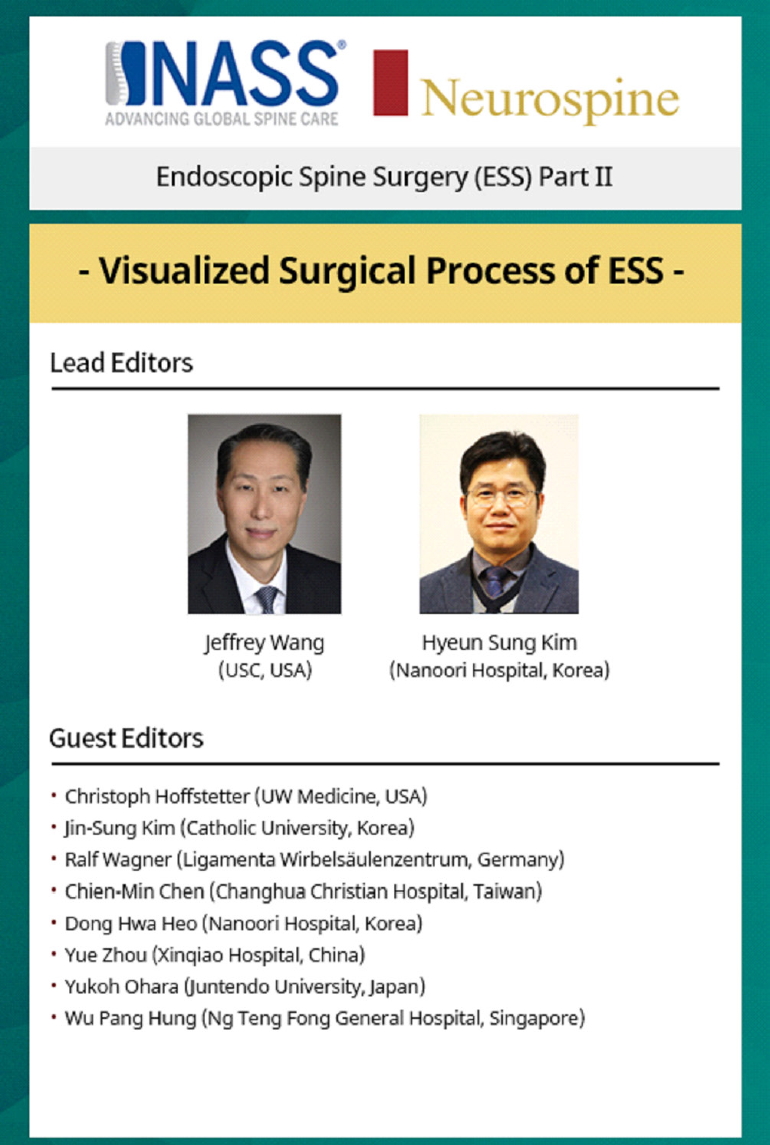Development of Endoscopic Spine Surgery for Healthy Life: To Provide Spine Care for Better, for Worse, for Richer, for Poorer, in Sickness and in Health
Article information

INTRODUCTION
In part of the wedding vow, when partners commit to support each other in various times of their lives, a common phrase is “to hold from this day forward, for better, for worse, for richer, for poorer, in sickness and health, to love and to cherish, until we are parted by death.” Spine conditions affect most people with age, in both high-income and low-income countries, including both people who are healthy and athletic and people with complex medical problems and those who are home-bound. Robust treatment strategies are needed for this diverse variety of patients with different needs presenting with various degenerative and injury-related spine conditions. Recent advances in endoscopic spine surgery are a testimony to the integration of modernised spine surgical skills with technological advances. In this Neurospine Special Issue: Endoscopic Spine Surgery Part II: Visualized Surgical Process, we put together articles from a team of established endoscopic spine surgeons around the globe to provide a technical update and share their experiences on how they handle various spinal conditions in various clinical scenarios with the aim of adding quality years of healthy life and providing spinal care for better, for worse, for richer, poorer, in sickness, and in health (Fig. 1).
FOR BETTER SPINE CARE: MINIMISING TISSUE DAMAGE IN PROLAPSED INTERVERTEBRAL DISCS DURING ENDOSCOPIC DISCECTOMY
Prolapsed intervertebral disc is a common spinal problem affecting young and active individuals, as well as older patients with degenerative spinal conditions. It affects 1%–3% of the population in their lifetime. Conservative treatment fails in roughly 10% of patients with a prolapsed disc, who then require consideration for surgical intervention [1]. Conventional open discectomy requires ipsilateral laminotomy or complete laminectomy, resection of the ligamentum flavum, and subsequent discectomy. Although it is an effective treatment with favourable patient-reported outcomes, it changes the paraspinal musculature, soft tissue, and the bony and ligamentous anatomy of the affected level, and causes epidural fibrosis following spinal surgery because fibrotic tissue replaces epidural fat [2,3]. Endoscopic discectomy has practical advantages. By using a safe surgical corridor in the transforaminal route with various techniques to approach the disc, it is possible to minimise bony resection and ligamentous disruption while reaching the site of the prolapsed intervertebral disc [4-7]. The benefits of these techniques also extend to the thoracic and cervical regions [8-10]. The delivery of magnified endoscopic vision close to the pathological area, bypassing soft tissue and bony obstacles along the path to the pathology, enables the targeted delivery of thermal energy, mechanical debridement of soft tissue, bony resection, and removal of pathology with less collateral damage. These techniques epitomise the principles of minimally invasive surgery, providing solutions for many types of prolapsed discs with potentially difficult access issues [11,12]. The long-term outcomes are comparable to those of open discectomy, but with a shorter hospital stay [13]. As the techniques of endoscopic spine surgery evolved, surgeons’ focus shifted to providing better spinal surgical treatment with less damage to local anatomy, minimising recurrence, and easing the learning curve of endoscopic spine surgery [12,14,15].
FOR WORSE CASE SCENARIOS (REVISION SURGERY, COMPLICATIONS, AND EXPANSION OF INDICATIONS): SOLUTIONS OFFERED BY ENDOSCOPIC DECOMPRESSION AND INTERBODY FUSION
Population aging has been accompanied by an increase in the incidence and prevalence of lumbar degenerative spine conditions. With a high prevalence of these conditions, such as spinal stenosis, spondylolisthesis, degenerative disc disease, and their associated spinal conditions, there is a demand for surgical techniques to provide effective decompression and fusion [16]. In head-to-head comparisons with open and minimally invasive microscopic decompression and fusion, full endoscopic uniportal and endoscope-assisted biportal decompression and interbody fusion achieved equivalent patient-reported outcomes, with better facet preservation, shorter hospital stays, improved perioperative pain management, and a lower infection rate [17-19]. With the wide application of open and endoscopic spine decompression and fusion surgery in patients with degenerative spine disease, there has been a corresponding increase in patients who present with conditions requiring revision surgery. Similarly, recurrence of prolapsed disc is a common long-term complication of discectomy. Performing revision surgery using endoscopic discectomy, decompression, and fusion techniques has the following benefits: (1) As minimally invasive techniques result in a smaller wound and less soft tissue dissection, there is a lower chance of wound dehiscence and infection [20]. Constant irrigation during endoscopic spine surgery is likely to reduce this risk even further. (2) A magnified endoscopic view with dissection done lateral to the dural scar tissue may decrease the risk of incidental durotomy [21]. (3) The reduced extent of soft tissue and bony dissection under endoscopic vision can potentially preserve enough tissue to prevent instability and the need for fusion [22-24]. (4) Alternative approaches to the same target site are possible with endoscopic spine surgery. For example, a contralateral approach can reach the same foraminal region in a previous surgical site where a paraspinal approach or transforaminal approach was used [23]. However, amid the optimism regarding the expansion of indications for endoscopic spine surgery to encompass increasingly challenging cases, one needs to be cautious of the potential complications of endoscopic surgery, such as incidental durotomy, neurological sequelae, and inadequate decompression, all of which are confounded by a steep learning curve [24-26].
FOR RICHER: COST OF ENDOSCOPIC SPINE SURGERY-RELATED EQUIPMENT
Worldwide, 266 million individuals (3.63%) have degenerative spinal conditions and suffer from lower back pain each year. The highest and lowest estimated incidence rates were found in Europe (5.7%) and Africa (2.4%), respectively. The distribution of cases depends on demographics, as low- and middle-income countries have 4 times as many cases as high-income countries [27]. Endoscopic spine surgery is dependent on technological developments. Advances in the endoscopic camera optical system and the development of endoscopic instruments and thermal energy delivery techniques such as side-firing lasers and radiofrequency coagulators present a double-edged sword. On one hand, these technological advances provide a safer platform to achieve the objectives of endoscopic spinal surgery, but on the other hand, using novel equipment increases the cost of endoscopic spine surgery. The way to resolve this dilemma is the more widespread usage of endoscopic spine surgery equipment, which —together with mass production—will hopefully drive the cost of surgery down. It is important for industry, health care policymakers, and endoscopic spine surgeons to be aware of the social responsibility of reasonable costs in the provision of endoscopic spine surgical care, in order to fulfil the objective of providing similarly effective minimally invasive spinal surgery regardless of the social background of the presenting patient [28].
FOR POORER: ADAPTATION OF TECHNOLOGIES USED BY OTHER DISCIPLINES IN SPINAL SURGERY
While various players attempt to reach an equilibrium to contain the costs of endoscopic equipment, we can draw comfort from the fact that endoscope-assisted surgery can adopt equipment that is available for use by our orthopaedic and neurosurgical colleagues and apply it to endoscope-assisted procedures such as unilateral biportal endoscopic (UBE) decompression and fusion. The camera system used in orthopaedic arthroscopy (e.g., for knee and shoulder surgery) can be used for UBE with some minor modifications. In a similar vein, some open spinal decompression and fusion equipment can be used in UBE surgery [29]. While there are debates on the approaches, benefits, and outcomes of uniportal versus biportal endoscopic spine surgery, evidence exists that both types of surgery yield favourable outcomes [17,30]. The ability to use locally available equipment would certainly encourage attempts to develop endoscopic practice despite variations in wealth and policies due to geographical differences.
IN SICKNESS: THE ROLE OF ENDOSCOPIC SPINE SURGERY IN PATIENTS WITH COMPLEX MEDICAL PROBLEMS
As it is increasingly frequent for complex medical problems to be well managed by other medical specialties, it is increasingly common for patients with multiple complicated comorbidities to require spinal operations. Some of these patients have a high risk of anaesthesia-related complications, which discourage both the patients and the treating physicians from pursuing surgical treatment [31]. General anaesthesia may cause issues in elderly patients, with postoperative complications including cognitive dysfunction and immobility-related complications such as deep vein thrombosis and sacral sores. However, these complications can be potentially avoided with various endoscopic spinal procedures that can be done under local anaesthesia and epidural anaesthesia, which allow for early postoperative recovery and mobility without a significant effect on the central nervous system [32-36].
IN HEALTH: SUMMARY AND CONCLUSIONS ON ADDING QUALITY YEARS OF HEALTHY LIFE BY ENDOSCOPIC SPINE SURGERY
The ultimate aim of all medical specialties is to add more quality years of healthy life for our patients. As patients have a longer life expectancy, it is important to treat their disabling spinal conditions appropriately to enable patients to live a satisfying, functional, and relatively pain-free life as long as possible. Endoscopic spine surgery closely follows the ethical principles of nonmaleficence, beneficence, justice, and respect for autonomy of the patients. One of the main principles of endoscopic spine surgery is minimising the collateral damage of surgery. With more experience, and hopefully with a magnified view of the structures in the endoscopic operating field, one can reduce the complications and tissue damage related to spine surgery. These efforts follow the principles of nonmaleficence. The positive outcomes of well-executed endoscopic spine surgery are well documented in the literature. With a further understanding of the indications and limitations of endoscopy, it will be possible to safely and effectively provide equivalent and possibly superior outcomes to patients in comparison to open surgery, thereby fulfilling the principle of beneficence. Justice of care is a complex issue in endoscopic spine surgery. There is a heavy dependence on advanced equipment to provide safe endoscopic care to patients, resulting in a risk that patients from places with limited resources may have problems accessing endoscopic care. The spine surgery community should work together with industry and healthcare facilities to tackle this issue. The ultimate aim is to provide the option of endoscopic spine surgery regardless of economic and social circumstances. With development of endoscopic training, the widespread availability of literature, and sharing of technical pearls, more surgeons will be trained to be proficient in endoscopic spine surgery. This development of skills, with an appropriate understanding of the limitations of endoscopic spine surgery, will provide an alternative option for both surgeons and patients to consider based on their personal values and beliefs. As such, endoscopic spine surgery allows more tailored treatment options for specific conditions, ultimately fulfilling the principle of respecting patient autonomy.
Notes
The authors have nothing to disclose.

